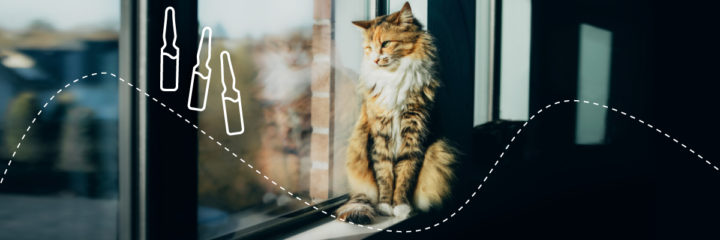
*Advertisement – brand name mentioned
Chronic kidney disease of the cat (CKD) is a progressive, incurable disease of predominantly older cats. Therefore, slowing down the renal destruction and improving the clinical symptoms is the main focus of treatment management. In this context, the demand for therapeutic and effective biological, natural or at least less “chemical” ways of treating a cat with chronic kidney disease is high.
Problem: Excretion of medications in CKD.
Particularly in a cat with kidney impairment, special attention is paid to the excretion and metabolism of drugs or other medical products. This is because in the course of the disease, the kidneys lose their ability to excrete toxins. However, many effective substances are metabolized in the liver and must then be excreted by the kidneys. This additional burden is not insignificant with an already reduced excretory capacity.
On the other hand, the CKD cat should also be treated for the corresponding symptoms and life-prolonging and quality-of-life-enhancing measures should not be disregarded. This often results in a cost-benefit analysis that cat owners ought to discuss with their veterinarian.
Solution: Therapy of CKD without drugs?
Fortunately, the market for the treatment of cats with chronic kidney disease is opening up to new therapeutic approaches. Product alternatives, some of which are not pharmaceuticals, are taking over veterinary practices. For decades, there were few products for the CKD-afflicted cat besides kidney diets, which nowadays are no longer unreservedly recommended by all cat experts. In the meantime, in addition to innovative and harmless approaches, for example to reduce uremic toxins (Renaltec®), there are also biological medicines that make a valuable contribution.
SUC: Many components with different approach
These include, for example, therapy with SUCSUC describes a special treatment consisting of a multitude of individual components (multicomponent). These are applied at different points in the therapy of CKD ( multitarget). SUC is an acronym derived from the ingredients: • Solidago compositum ad us. vet. • Ubiquinone compositum • Coenzyme.... SUC describes a special treatment consisting of a multitude of individual components (multicomponent). These components are applied at different points in the treatment of CKD (multitarget).
SUC is an acronym derived from the ingredients:
- Solidago compositum ad us. vet.
- Ubiquinone compositum
- Coenzyme compositum
In a recent comparative study in cats with chronic kidney disease, 33 cats received SUC and 35 cats received benazepril over a period of 168 days. The latter is a drug used to reduce blood pressure (angiotensin-converting enzyme inhibitor, or ACE). Benazepril is used when the cat excretes proteins in the urine (proteinuriaIncreased protein in urine, leading to loss of protein. Normally, only a very small amount of protein is excreted in the urine. In chronic kidney disease, the amount lost may increase. High blood pressure damages blood vessels in the nephrons making them more permeable and...). The goal in the presence of proteinuria is to reduce blood pressure in the kidneys, in part to protect the kidneys themselves. Increased blood pressure can damage the kidneys and support further kidney destruction and thus the progression of CKD.
Nephron destruction is progressive
Chronic kidney disease leads to small inflammatory foci in the functional filtration units of the kidney, the so-called nephronsNephrone sind die Filtereinheiten der Nieren...., which are then destroyed and remodeled with connective tissue. Connective tissue cannot perform the tasks of the functional units, so kidney performance decreases. The uremic toxin indoxyl sulfate has been identified as one cause of this nephron inflammation and subsequent destruction. There are new approaches to massively reduce indoxyl sulfate by means of the above-mentioned selective high-performance adsorbents (Renaltec®).
The Solidago (goldenrod) component in the SUC complex is thought to have an anti-inflammatory and mild antihypertensive effect comparable to that of benazepril. The other composite components in SUC may reduce oxidative stress in renal tissue. Oxidative stress is also caused by indoxyl sulfate. Reduction of indoxyl sulfate or anti-inflammatory and antihypertensive effects may have a positive effect on the functional units (nephrons) in this respect, so that they are preserved longer.
Therapy success with CKD
The aim of the therapy of CKD is on the one hand to maintain or improve the quality of life of the cat. This also includes improving existing clinical symptoms. Since each cat shows very different symptoms, therapeutic approaches may differ in this regard. Equally important is slowing the progression of CKD. CKD cannot be stopped because different vicious cycles exist that fuel further nephron destruction. Fortunately, there are many approaches to break these vicious circles, allowing to increase the life expectancy of a CKD cat.
Improved clinically – creatinine unchanged
The use of SUC also showed in the above-mentioned study over 168 days that creatinineCreatinine is a breakdown product of muscle metabolism. Its blood level is dependent, among many factors, on age, weight, nutritional status and muscle mass. Hence, creatinine levels in the blood vary from individual to individual. Creatinine is continuously excreted in the urine. Increased blood creatinine... levels did not improve, although the cats’ quality of life very much did. The authors of the study attribute this to the fact that the existing renal impairment cannot be reversed. Also, the authors report that the correlation between clinical improvement in the cat and blood levels of creatinine was not present in the study.
Improvement of quality of life and kidney values
In addition to improving the quality of life, the above-mentioned uremic toxin adsorber can also improve kidney values such as SDMASDMA = Symmetrical Dimethylarginine, which is a degradation product of the amino acid arginine and is excreted solely through the kidneys. SDMA is a highly specific biomarker for kidney function in cats. Read more: SDMA test (blood test)... and creatinine. Here, the cause lies in the excretory relief of the kidneys. Since indoxyl sulfate is usually excreted by the kidneys, a reduction in indoxyl sulfate blood levels can then result in more excretory capacity being available for creatinine and other substances. This is a desirable side effect of Renaltec®. Both SUC and Renaltec® can be used individually or together at any IRIS stage of CKD.
Bibliography:
- Brandenburg, U.; Braun, G.; Klein, P.; Reinhart, E. (2020): The Multicomponent, Multitarget Therapy SUC in Cats with Chronic Kidney Disease: A Multicenter, Prospective, Observational, Nonrandomized Cohort Study, Complement Med. Res, 27 (3), S. 163–173. https://doi.org/10.1159/000506698


